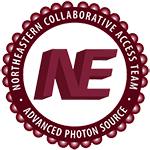Structure and psoralen DNA crosslink repair activity of mycobacterial Nei2.
Publication Type:
Journal ArticleSource:
mBio, Volume 15, Issue 8, p.e0124824 (2024)Keywords:
Bacterial Proteins, Cross-Linking Reagents, Crystallography, X-Ray, DNA Damage, DNA Repair, DNA, Bacterial, Ficusin, Gene Deletion, Mitomycin, Mycobacterium smegmatisAbstract:
<p>Nei2 is a monomeric enzyme with AP β-lyase activity on single-stranded DNA. Expression of Nei2, and its operonic neighbor Lhr (a tetrameric 3'-to-5' helicase), is induced in mycobacteria exposed to DNA damaging agents. Here, we find that deletion sensitizes to killing by DNA inter-strand crosslinker trimethylpsoralen but not to crosslinkers mitomycin C and cisplatin. By contrast, deletion of sensitizes to killing by all three crosslinking agents. We report a 1.45 Å crystal structure of recombinant Nei2, which is composed of N and C terminal lobes flanking a central groove suitable for DNA binding. The C lobe includes a tetracysteine zinc complex. Mutational analysis identifies the N-terminal proline residue (Pro2 of the ORF) and Lys51, but not Glu3, as essential for AP lyase activity. We find that Nei2 has 5-hydroxyuracil glycosylase activity on single-stranded DNA that is effaced by alanine mutations of Glu3 and Lys51 but not Pro2. Testing complementation of psoralen sensitivity by expression of wild-type and mutant alleles in ∆ cells established that AP lyase activity is neither sufficient nor essential for crosslink repair. By contrast, complementation of psoralen sensitivity of ∆ cells by mutant alleles depended on Lhr's ATPase/helicase activities and its tetrameric quaternary structure. The operon comprises a unique bacterial system to rectify inter-strand crosslinks.IMPORTANCEThe DNA inter-strand crosslinking agents mitomycin C, cisplatin, and psoralen-UVA are used clinically for the treatment of cancers and skin diseases; they have been invaluable in elucidating the pathways of inter-strand crosslink repair in eukaryal systems. Whereas DNA crosslinkers are known to trigger a DNA damage response in bacteria, the roster of bacterial crosslink repair factors is incomplete and likely to vary among taxa. This study implicates the DNA damage-inducible mycobacterial gene operon in protecting from killing by inter-strand crosslinkers. Whereas interdicting the activity of the Lhr helicase sensitizes mycobacteria to mitomycin C, cisplatin, and psoralen-UVA, the Nei2 glycosylase functions uniquely in evasion of damage caused by psoralen-UVA.</p>
